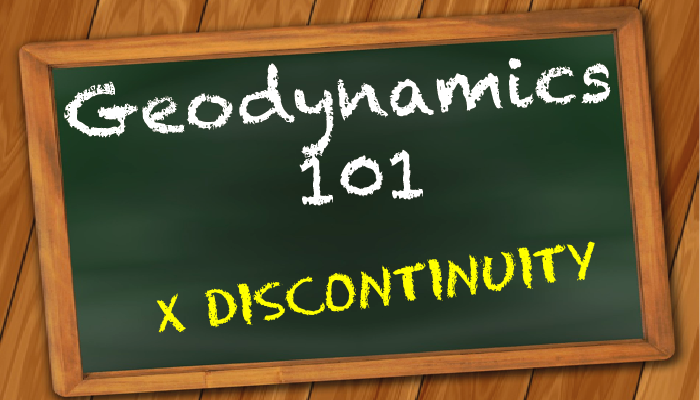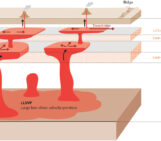
Seismic discontinuities necessitates mechanisms that would generate them and therefore, help us better understand the internal structure of the Earth. This week, Martina Monaco talks about the mysterious X-discontinuity — observed under several hotspots at upper mantle depths of ~ 290 km —and how it relates to the rising plumes.
According to the Oxford Dictionary, only 400 words in the English language start with the letter X — a count that includes rare and unused words. A pity handful, compared to the 13690 registered words starting with S.
The popular imagination often regards the letter X as the epitome of mystery, uncertainty, vagueness, and geophysicists are no exception. Dr. J. Revenaugh and Dr. T. H. Jordan, in their 1991(a) paper, first resolved a long-standing naming issue, and used the most cryptic letter in the alphabet to baptize an unfathomable, “enigmatic” in their own words, mid-upper mantle discontinuity, whose occurrence manifested via an “impedance increase near 320 km, and its explanation in terms of standard upper mantle mineralogies does not appear to be straightforward”.
The X discontinuity displays a strongly local character — it is only observed under selected tectonic settings, such as the world-known Hawaiian hotspot — and, after much trial and error, it was determined that one of the most likely culprits for its appearance is a great transformation happening in the silica minerals (from coesite to stishovite) of the heavier basaltic material present at those depths.
Geodynamicists and seismologists have long acknowledged the existence of stishovite — and, more generally, of basaltic material — in the mantle. The most classical models treat the mantle itself as a mixture, where 85% of it is ‘autochthonous’ mantle rocks, and the remainder is basalt brought into depths by former subduction zones, and circulating in the mantle thanks to the rising mantle plumes.
These percentages are not casual. Like in the perfect recipe, they ensure that the two components mix, and that mantle plumes can still rise to the surface, despite carrying denser components that likely get stuck and shall never be determined with certainty.
However, recent seismological studies under Hawaii (Kemp et al., 2019) added a new layer to this problem. Here, the upper mantle shows both the X discontinuity and perturbations so great that they argued for as much as 40% of denser material. An enormity compared to the classical 15%.
So, as plume catchers —ahem, Geodynamicists — we decided to compute ourselves how much denser material a mantle plume can actually carry, and see what percentage of it gets stuck around 300 km depth, which is where the X discontinuity was observed.
To do so, we set up a box with two materials mimicking the real-Earth mantle densities: a lighter background, representing a section of the Hawaiian mantle plume, and heavier basaltic blobs, both rising at a known starting speed.
The amount of material that rises is predetermined, and includes percentages from 10 to around 35%. The deformation to the denser basalt, its ascent velocity, and the amount of blobs that rises depend on the predetermined value of viscosity imposed, and on the ratio between the densities of the blobs vs the background.
Schematic representations of three selected model runs, one for each regime. The top row displays the model box with the background plume (in shades of blue), and the denser blobs (in shades of red). The discoloration in the blobs represents the density jump in the modeled X-Discontinuity. The bottom row shows the patterns of the velocity vectors.
For increasing viscosities (left to right), we note that the blobs deform gradually less (they retain their shape and
rise with decreased speeds). Only for the intermediate regime (middle panels) we have a combination of
material accumulating and deforming around the X-Discontinuity.
Upon running each model over a 100 Myr time span and with all the different parameters above, we found three main regimes (or patterns) in the rising blobs (see Figure 1). When the viscosity is too low with respect to the density, they sink and not enough basalt rises, so the occurrence of the X Discontinuity is not explained. When the viscosity is too high, no deformation alters the blobs, and the results are again not applicable to a real situation.
Intermediate viscosities lead to the most interesting results. The blobs rise, sink, and hover at the depth range of interest for the whole 100 Ma. And the greatest part? They actually get stuck in the mid-upper mantle, such that they stay in the box for long enough times that the basalt percentages can get close to or more than 40%, even assuming the classical influx percentage of 15%!
We like to consider this groundbreaking finding only as the starting point of a long-range work, that may not only help shed a better light on the Hawaiian plume dynamics and the X Discontinuity, but also be the start of a huge revision of some of the longest-standing dogmas in Geodynamics. Ultimately, our goal is to help unravel the unfathomable and beautiful mystery of the Earth’s mantle, one denser blob at a time.
References:
Revenaugh, J., & Jordan, T. H. (1991). Mantle layering from ScS reverberations: 2. The transition zone. Journal of Geophysical Research: Solid Earth, 96(B12), 19763-19780. Kemp, M., Jenkins, J., Maclennan, J., & Cottaar, S. (2019). X-discontinuity and transition zone structure beneath Hawaii suggests a heterogeneous plume. Earth and Planetary Science Letters, 527, 115781.





